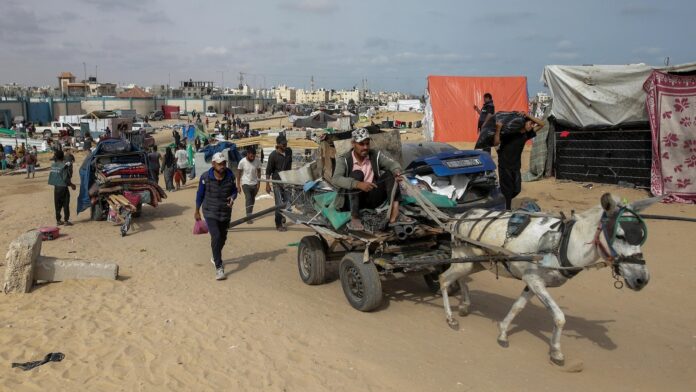WASHINGTON — Defense experts who viewed debris footage of an Israeli airstrike that caused a deadly fire in a camp for displaced Palestinians wondered why Israel didn’t use smaller, more accurate weapons when so many civilians were around. They said the bombs used were likely American-made.
The attacks, targeting Hamas operatives, killed as many as 45 people sheltering in a temporary displaced persons camp near the southern Gaza city of Rafah on Sunday, drawing international condemnation.
Israel is investigating the attack but says the Hamas targets were 1.7 kilometers (1 mile) from a declared humanitarian zone and that the pre-attack assessment showed there would be no expected harm to civilians.
But displaced civilians were scattered across the area, and Israel had not ordered any evacuations. So even if the tents that burned were not within the marked humanitarian zone, the civilians there thought it was safe.
Israel, which was attacked by Hamas on Oct. 7, 2023, did not say how far the burned tents were from the compound it bombed on Sunday. It emphasized that although there were no tents “in the immediate area,” due to “unforeseen circumstances, a fire tragically occurred and claimed the lives of Gazan civilians in the area.”
Images released by the Israeli army appear to show people walking next to the targeted buildings just before the blast. The images also appear to show tents nearby.
Israel has not identified the bombs it used, but Admiral Daniel Hagari, a spokesman for the Israeli military, has emphasized that the country chose the smallest munition its fighter jets could carry – each carrying 17 kilograms of explosive material – and that an inadvertent secondary explosion may have caused the fire.
Even the smallest jet-launched munitions can be too big if civilians are nearby because of the way they explode and can send fragments far, defense experts say.
Images posted to social media from the tent camp Monday and verified by The Associated Press showed a CAGE code, a unique identifier assigned to U.S. government suppliers, on pieces of the exploded weapons.
Based on those images and satellite photos of the debris field, two defense experts said the bombs used were likely U.S.-made 250-pound (113-kilogram) small-diameter GBU-39 bombs.
Although smaller than many other weapons the US has supplied to Israel, these bombs can still cause a large amount of damage. The entire 250-pound grenade and components are designed to spit out fragments that can travel up to 2,000 feet.
“You essentially have two bombs that they use so the fragments can travel 600 meters in a tightly packed area. So that just doesn’t add up when they’re trying to limit casualties,” said Trevor Ball, a former Army explosive demolition technician.
Ball said the serial number on the tail kit parts and the shell debris in the photos identify the munition as the 250-pound GBU-39. According to Ball and Mark Cancian, a retired Marine Corps colonel and senior advisor to the Center for Strategic and International Studies, it is unusual to describe a bomb by its explosive charge — in this case 37 pounds — in instead of its total weight.
The debris field in Gaza indicates that the bombs may detonate before impact, which would kill the intended targets but also risk unintended deaths, Ball and Cancian said. The footage showed a small hole where shrapnel was found.
The GBU-39’s fuse settings can be adjusted to detonate the bomb on impact, which would leave a crater at the site, or a delayed explosion if the goal is to allow it to penetrate deeper into a target first.
They can also be set to explode in mid-air just before impact, to ensure multiple targets are hit. But that setting also maximizes damage to the area, which could explain a secondary explosion even if weapons or other flammable material were present some distance away, Ball said.
Secretary of State Antony Blinken told reporters on Wednesday during a visit to Moldova that the US is awaiting an investigation to determine which weapons were used and how they were deployed.
Even if that confirms that Israel used a small-bore weapon, “we also see that even limited, targeted, targeted attacks – designed to target terrorists who have killed innocent civilians who are planning to kill more – even this type of operations can have terrible consequences. horrific, unintended consequences,” Blinken said.
The defense experts said Israel had better options than the GBU-39 if civilians were in the area.
The Israelis have previously used drones to launch weapons that are smaller and more precise, Cancian said. These precision airstrikes used over the years have caused little damage beyond the immediate target.
For example, Israel could have used a smaller anti-personnel weapon in this attack called the mini-Spike, which would not have created such a large area of rubble if it had targeted specific Hamas leaders, Cancian said.
The US has withheld a shipment of even larger 900-kilogram bombs from Israel, fearing they would be used in Israel’s Rafah operation, where more than 1 million Palestinians gathered after Israel bombed other parts of Gaza. Now, the same number of people have escaped from Rafah and dispersed to makeshift tent camps and other areas.
Sunday’s attack shows that even the smaller 250-pound bombs that the U.S. has continued to supply may be too large for use near densely packed refugee areas, Cancian said.
White House national security spokesman John Kirby said Wednesday that the US was still trying to gather information from Israel about the deadly attack in Rafah. He declined to discuss the specific munitions used by Israel, but said Israel’s public comments about the munitions used “certainly indicate a desire to be more deliberate and precise in their targeting.”
___
Federman reported from Jerusalem. Associated Press writers Matthew Lee in Prague, Ellen Knickmeyer and Zeke Miller in Washington and Kareem Chehayeb in Beirut, Lebanon, contributed.



